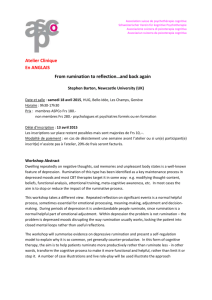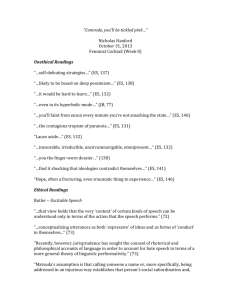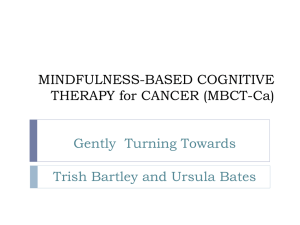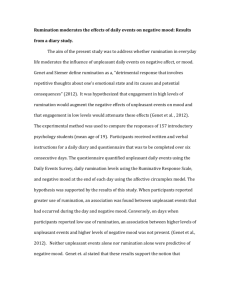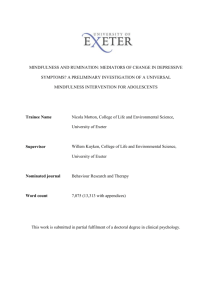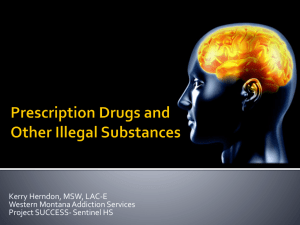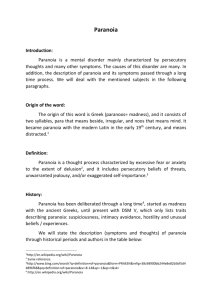the role of rumination in psychosis
advertisement
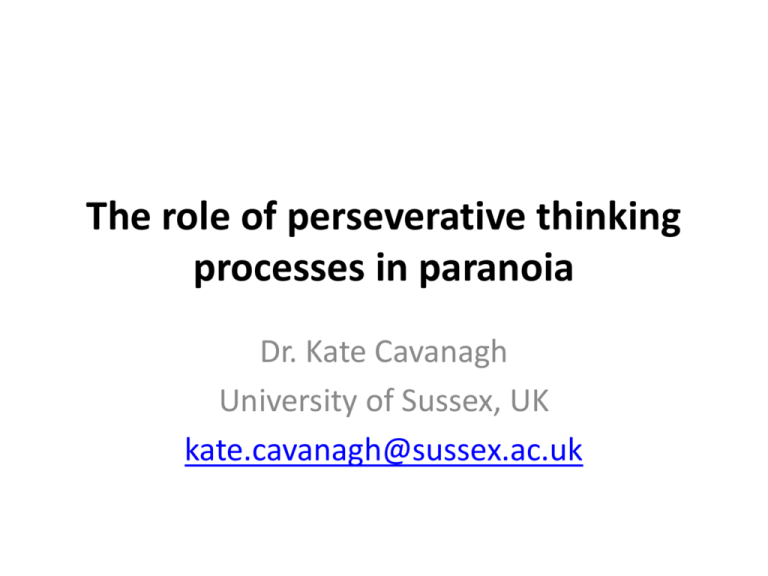
The role of perseverative thinking processes in paranoia Dr. Kate Cavanagh University of Sussex, UK kate.cavanagh@sussex.ac.uk It’s not what you think it’s the way that you think it • In cognitive psychopathology research focuses on both the content of automatic thoughts, attributions and beliefs • But also on the way we respond to these thoughts (cognitive or ‘thinking’ processes) and the implications of this for further thoughts, feelings and behaviour – For example: if the idea ‘I look foolish’ crosses my mind – how I respond to that thought (focus on it, evaluate it, dismiss it or distract from it, argue with it etc) will have an effect on future thought content, how I feel and my behaviour over time. Outline • Repetitive thought and repetitive negative thinking • Role of repetitive negative thinking processes in psychopathology • Hypothesised role of repetitive negative thinking processes in paranoia • Research programme exploring the role of rumination in paranoia – Questionnaire based study (correlation) – Lab based studies testing the causal relationship between rumination and the maintenance of suspicious and mistrustful beliefs in student sample • Conclusions, questions and future directions Colleagues and collaborators • Newcastle University, UK: – Rob Dudley, Jennifer Simpson, Bryony McGregor • University of Sussex, UK: – Cheontell Barnes, Stacey Hemmings, Deidre Robertson, Cristina Martinelli and Moitree Banerjee. Repetitive thought • The “process of thinking attentively, repetitively or frequently about one’s self and one’s world” – Segerstrom et al. (2003, p.909) e.g. planning, reflection, emotional processing, problem solving, working through, worry, rumination, post-event processing Repetitive thought • May be ‘adaptive’ or ‘maladaptive’ • Vary on three dimensions (Watkins, 2008) – Valence of the thought content (positive vs negative – Intrapersonal and situational context (positive vs negative) – Level of construal adopted (abstract vs concrete) + – Level of volition/control (Ehring & Watkins, 2008) Repetitive thought • With ‘constructive’ or ‘unconstructive’ consequences for mental and physical health (Watkins, 2008) Constructive consequences Unconstructive consequences e.g. recovery from upsetting and traumatic events, adaptive preparation and planning, recovery from depression, uptake of health promoting behaviours e.g. Depression, anxiety, difficulties in physical health Repetitive negative thought Transdiagnostic process (Harvey et al., 2004) • “same process across disorders, which is applied to disorder specific content’ (p. 192; Ehring & Watkins, 2008 • Repetitive • Passive / Relatively uncontrollable • Focused on negative content Repetitive negative thought • Growing evidence of repetitive negative thinking processes in various types of psychopathology Worry • Worry – repetitive thought about “future potential threat, catastrophes, uncertainty and risks” (Watkins, 2008, p. 164) – Cardinal feature of GAD (DSM-IV APA, 1994), – Also associated with OCD, PTSD, depression, insomnia, bipolar disorder (and psychosis) Rumination • Rumination – A “mode of responding to distress that involves repetitively and passively focusing on symptoms of distress and the possible causes and consequences of these symptoms” (Nolen-Hoeksema, Wisco & Lyubomirsjy, 2008, p. 400) Cardinal feature of depression (Nolen-Hoeksema, 2008) – but also evident in social phobia (Brozovich & Heimberg, 2008), PTSD, GAD and panic (Smith & Alloy, 2008) and associated with binge eating and alcohol abuse (NolenHoeksema et al., 2008) and negative symptoms of psychosis (emotional withdrawal, stereotyped thinking, Halari et al., 2009). Repetitive negative thought • Not just ‘associated’ to a range of disorders • But playing a causal role The role of rumination in depression • Evidence of higher levels of rumination in people with depression (and predicts future episodes of depression) • Causal role is supported by evidence of the effects of rumination induction in depressed individuals* (versus distraction), which leads to – worsened mood (Donaldson & Lam, 2004) – Increased retrieval of negative memories (Lyubomirsky, Caldwell & Nolen-Hoeksema, 1998) – Distorted interpretation of events and negative expectancies of the future (Lyubomirky & Nolen-Hoeksema, 1995) – Indesciveness (Randenborg et al., 2010) – Withdrawal and inactivity (Martell et al., 2001) • All factors that may play a role in maintaining depression Repetitive Negative Thinking • Evidence of RNT in 13 disorders – Depression, PTSD, Social Anxiety Disorder, OCD, Insomnia, eating disorders, pain disorder, hypochondriasis, alcohol use disorder, psychosis and bipolar disorder – Including psychosis, where high levels of RNT, described as worry, have been measured in groups with persecutory delusions (Freeman & Garety, 1999; Startup, Freeman & Garety, 2007) and other presentations of psychosis (Morrison & Wells, 2007) Harvey et al., 2004; Erhing & Watkins, 2008 Perseverative cognition • “The repeated or chronic activation of the cognitive representation of one or more psychological stressors” (Brosschot et al., 2006) • Description of repetitive negative thinking adopted in research relating to stress-related physiological activation and its health consequences Summary • Significant evidence of a transdiagnostic role for repetitive negative thought (RNT) • RNT associated with many Axis 1 disorders • Evidence of a causal role for RNT in onset and maintenance of transdiagnostic distress • Is RNT relevant to psychosis / paranoia and persecutory delusions? Repetitive negative thinking processes in persecutory delusions, paranoia and psychosis • ‘Preoccupation’ as a cardinal feature of delusional beliefs – e.g. Chadwick & Lowe (1990; belief conviction, belief preoccupation) – E.g. Peters et al. (1999; distress, preoccupation, conviction) Repetitive thinking processes in psychosis underpins delusional distress • “…further appraisal of the experience (e.g. worry and rumination)” Freeman (2007),p451 Repetative thought in psychosis • Limited research available • High levels of worry found in – Individuals with current persecutory delusions (Freeman & Garety, 1998; Startup, Freeman & Garety, 2008) – And, other presentations of psychoses (Morrison & Wells, 2007) • Association between rumination and negative symptoms – A relationship between rumination and measures of emotional withdrawal and stereotyped thinking, in participants with diagnosis of schizophrenia (Harari et al., 2009) Rumination and psychosis • Idea of ‘rumination’ or ‘brooding’ as playing a role in paranoia has clinical face validity – Repetitive thinking about the meaning, causes and consequences of activated threat beliefs and anxious mood • But, little research has explored the role of rumination in persecutory or paranoid beliefs Does rumination play a role in paranoia? • A questionnaire study investigating the relationship between rumination and paranoid ideation in a student sample* • Two lab-based studies investigating the effect of rumination (versus distraction) on a personal threat belief – 1. autobiographical memory of suspicious or mistrustful event (within subjects design) – 2. in vivo exposure to a ‘paranoia prime’ (between subjects design) Relevance of non-clinical studies • There is a continuum of severity of paranoia in the general population (Os & Verdoux, 2003) – 15-20% regularly engage in paranoid thinking • Non-clinical and clinical paranoia are associated with the same risk factors (Freeman, 2007) • Presence of non-clinical paranoia increases likelyhood for a subsequent diagnosis of psychosis • Non-clinical paranoia is of interest in its own right, but may also inform our understanding of clinical paranoia and persecutory delusions Is rumination associated with paranoid ideation? Questionnaire Study Simpson, Dudley, McGregor & Cavanagh (under review) • 133 student participants from Newcastle University, UK • 40 males and 92 females (data missing for one participant) • Mean age = 20 (SD=3.9) • Ethnicity 91% white British, 7% white other, 2% Asian. • Measures – Fenigstein Paranoia Scale (Fenigstein & Vanable, 1992) • ‘I’m sure I have been talked about behind my back’ • ‘some people have tried to steal my ideas and take credit for them’ – Rumination Response Scale (Nolen-Hoeksema & Marrow, 1991) • ‘think about your shortcomings, faults and mistakes’ • ‘write down what you are thinking and analyse it’ – Positive and Negative Affect Schedule (Watson, Clark & Tellegen, 1988) – (plus other measures not reported here) Result of Pearson’s Correlation and Significance Values between variables (n=129) Paranoia Scale PANAS negative PANAS,negative 0.31** PANAS,positive -0.01 -0.16 Ruminative Response Scale 0.46** 0.52** PANAS positive -0.10 • Regression analysis indicated that rumination predicts significant additional variance in paranoia when negative mood is accounted for. Key: PS=Paranoia Scale, PANAS=Positive and Negative Affect Scale, SBQ=Safety Behaviour Questionnaire, RRS=Rumination Response Scale. *p<0.05 **p<0.01 • Correlational analysis supports the idea that rumination may be associated with paranoid ideation • This effect is over and above the processes intrinsic to negative mood • Next step, to test hypothesis that this is a causal relationship in the lab… Does rumination on paranoid ideation increase conviction in paranoid ideas and feelings of paranoia? Simpson, McGregor, Dudley, Cavanagh (under review) • 25 University Students – 22 females, mean age 20 (SD=3), 96% white • Autobiographical memory procedure – “Bring to mind a time when you felt suspicious or mistrustful of another persons intentions…” – “focus on the events that made you feel suspicious or mistrustful” • Within subjects design – With that memory held in mind think about…(counterbalanced) • Rumination (e.g. ‘Why people treat you the way they do’?) • Distraction (e.g. ‘the layout of your local supermarket aisles’) • Based on Rusting & Nolen-Hoeksema (1998) • Measures of procedure fidelity and adherence, conviction in threat beliefs, self-reported distress etc Design Baseline Measures Paranoia Induction: Autobiographical memory Rumination / Distraction Tasks (counterbalanced) Outcome measures Fidelity checks: memory procedure Prior to Rumination Task Prior to Distraction Task How clearly can you remember the 73.1(21.0) incident? 76.8 (21.5) To what extent did you feel mistrustful or suspicious of the other person/people? 60.6 (19.3) 67.3 (21.5) To what extent did you feel that you were at threat of physical harm or psychological harm 47.4 (28.3) 49.0 (29.9) To what extent did you feel that the 34.9 (27.5) person(s) meant to cause harm? 34.4 (27.7) Thinking tasks • Rumination induction – 15 rumination items and asked to spend 8 minutes thinking sequentially about the meaning of the items. – e.g. “Think about why people treat you the way they do” and “Think about how you react to other people • Distraction induction – 15 externally-focused distraction items – e.g. “Think about the layout of the local post office” and “Think about a double-decker bus driving down the street” • All items were taken from Rusting and Nolen-Hoeksema, (1998) rumination procedure. • Matched for instructions and length of task Adherence checks: thinking tasks Rumination Task Distraction Task Percentage of time you managed to stay focused on the task 76.0 (12.1) 75.3 (15.2) Extent you were able to follow the instructions of the task 87.2 (13.5) 89.4 (10.6) Proportion of the time you spent thinking about yourself or other people? 87.4 (8.6) 43.0 (31.1) Proportion of the time you spent trying to understand or make sense of things? 70.0 (19.5) 45.8 (30.8) Outcomes (nb. baseline = post-prime) 140 20 18 120 16 100 14 80 12 Baseline Rumination 60 Distraction 40 Baseline 10 Rumination 8 Distraction 6 4 20 2 0 0 Threat belief VAS paranoia Rumination vs distraction, p<0.05 Baseline vs distraction, p<0.05 Baseline vs rumination, ns Rumination vs distraction, p<0.05 Baseline vs distraction, p<0.05 Baseline vs rumination, ns Conclusions • Rumination appears to be associated with the maintenance of threat beliefs and paranoid feelings following recall of an autobiographical memory characterised by suspicion/mistrust • Distraction appears to remediate threat beliefs and paranoid feelings • Next step – does rumination have a similar effect on paranoid threat beliefs in vivo? Martinelli & Cavanagh (in prep) • 37 students – 30 females, mean age = 24.5 (SD = 3.9), • In vivo paranoia induction – concern about potential harm from an other person • Between subjects design – With these events held in mind think about… • Rumination (e.g. ‘Why people treat you the way they do’?) • Distraction (e.g. ‘the layout of your local supermarket aisles’) • Based on Rusting & Nolen-Hoeksema (1998) • Measures of state paranoia scale (adapted from Freeman et al), time on task, distress etc Association between trait paranoia and RNT • Trait paranoia and trait perseveration were highly correlated, r = 0.54, p<0.001. • Supporting the idea that RNT and paranoia are related Martinelli & Cavanagh (in prep) Procedure Rumination Baseline Measures Paranoia Induction: In vivo Outcome measures Distraction Induction of paranoia • Previous studies have used different protocols to initiate in situ paranoia • Prevost et al (2010) – participants told there was a hidden goal to the study, their cerebral activity would be manipulated via electrical currents during the experiment, and were given the impression they were being observed from behind a one-way mirror (paranoia not measured) • Ellet et al.(2008) exposure to deprived urban environment (increased paranoia) • Ellett & Chadwick (2007) video camera observation during task (increased paranoia – but artifact of self-focus/social anxiety?) Our paranoia induction procedure – Sit in a dark room for 5 minutes, facing a wall with back to door, after some time someone might come in and might interact with you in a mildly unpleasant way – e.g. pinch you, tickle you, say something unpleasant to you… – Demonstrated to elevate state paranoia in pilot studies. Measuring state paranoia Freeman et al (2007) State Social Paranoia Scale – designed to capture participants responses to a ‘social’ situation • • • • “someone was hostile towards me” “someone had it in for me” “I felt safe…” “everyone was pleasant” etc Freeman et al have found that more than 1/3rd people report paranoid thoughts even when the social environment is neutral (2008) Was the paranoia induction effective? 30 25 Post-paranoia 20 Neutral situation 15 Freeman nonclinical 10 Freeman clinical 5 0 Mean State Paranoia Scale • Suggests our induction procedure was effective in eliciting ‘paranoia’ in our participants State paranoia scale • No difference between groups after paranoia induction – t(35) = 0.6, ns • Time x Condition interaction effect for thought process – F (1,35) = 7.1, p = 0.01 • Post-test differences • Distraction v Rumination – t(35) = 2.3, p = 0.03 No differences between groups in following instructions, concentration, time on task etc Findings of Martinelli & Cavanagh study • Paranoia induction appeared to raise state paranoia (needs validation/replication) • Rumination on this ‘dark-room’ experience was associated with maintenance of feelings of paranoia • Distraction was associated with reductions in feelings of paranoia • Baseline paranoia was associated with baseline perseverative style, and response to the paranoia induction. • Other methodological factors did not account for the effects of rumination on final level of paranoid ideation Conclusions • Rumination appears to be associated with maintenance (elevation?) of threat beliefs and feelings of paranoia associated with exposure to ambiguous/threatening interpersonal situations • Distraction appears to remediate paranoid ideas and mood (at least in the short term) • This replicates and extends a significant body of research supporting the transdiagnostic role of repetitive negative thinking processes • Limitations to these studies in terms of small sample sizes, use of non-clinical examples of suspicious threat beliefs etc Questions • Does this have any implications for our understanding of clinical paranoia/persecutory delusions? • How can we reconcile evidence of both repetitive negative thinking and ‘jumping to conclusions’ reasoning biases in relation to paranoia and persecutory delusions? • How might we extend our knowledge of paranoia processes in non-clinical samples? • How similar are these measured effects to those found in ‘post-event processessing’ in social anxiety? • Other questions…. Future research should explore… • Bio-psycho-social mechanisms underlying the relationship between rumination and suspicious and mistrustful thinking in non-clinical populations • The role of repetitive thought in paranoid ideation in clinical populations • The impact of keeping rumination and other types of perseveration in mind when working therapeutically with suspicious and mistrustful thinking and paranoia in clinical settings – E.g. can RNT therapies offer benefit in this domain? Thank-you Kate Cavanagh DPhil DClinPsych Senior Lecturer in Clinical Psychology Director of the Interactive Wellbeing Lab University of Sussex, UK. kate.cavanagh@sussex.ac.uk
